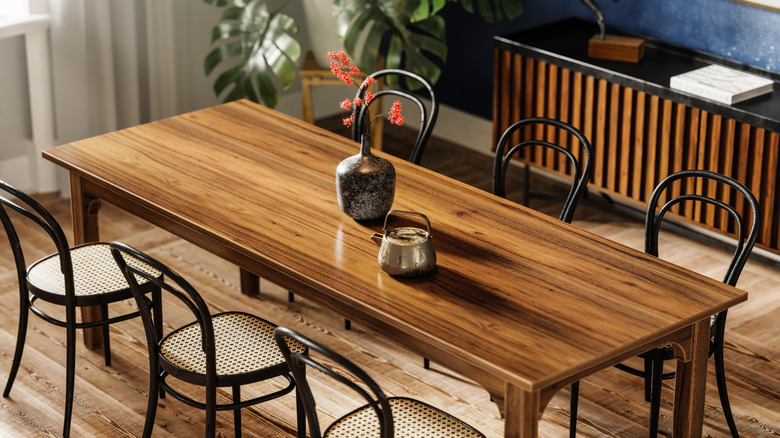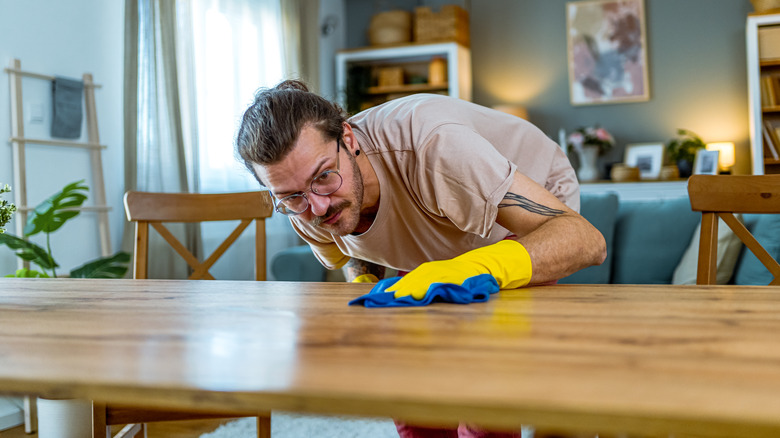Bring Shine Back To Your Wood Furniture With A Kitchen Essential
It's difficult to top the warm elegance that wooden furniture adds to a home. These pieces are incredibly sturdy, allowing them to last for years if cared for properly. Unfortunately, wood furniture is vulnerable to several kinds of damage, including UV light exposure, moisture, and general wear and tear. Even neglecting to dust your wooden table or chest of drawers regularly can cause it to become dull and faded over time. You don't need to buy an expensive product to restore your furniture's shine, though. The olive oil you have in your pantry is an effective, all-natural alternative to store-bought polishes and cleaners, helping to condition the wood and restore its luster.
Beyond its inclusion in many of your favorite recipes, there are several surprising uses for olive oil in your home. However, maybe it shouldn't be quite so unexpected that olive oil can benefit wood furniture. It's rich in fatty acids that can help rehydrate wood and prevent it from becoming dull and brittle. It can also help prevent fading due to UV damage, which is particularly helpful for wood furniture that sits in front of a window and receives significant sun exposure. Olive oil can even help fill in scratches and dents in wood to help your furniture's finish appear smoother.
How to condition wood furniture with olive oil
Olive oil alone is enough to work as an effective conditioner for wood furniture. It's important to ensure that the item's surface is completely free of dirt, dust, and other debris before you apply the oil, though, so use a damp cloth to wipe away any residue from the furniture. Afterward, dry the surface thoroughly. If there's any moisture on the furniture, the oil may seal it in place, causing the wood to warp, swell, and discolor over time.
You don't want to make a huge mistake with your wood furniture, so it's always a good idea to test the olive oil on a small, inconspicuous spot to see how the wood and its finish react before applying it all over. Once you're certain that it's safe to use, add a small amount of olive oil to a clean, lint-free cloth, such as a microfiber towel. Spread the oil over the furniture, taking care to work in the direction of the grain.
After you've applied the oil to the entire piece, let it absorb for at least 15 minutes. Use a clean, dry cloth to buff the surface and remove any excess oil that dirt and other debris might get stuck to. Your furniture should have a beautiful shine to it as the oil absorbs into the wood.
Mix olive oil with an acid to clean and polish
If you want to clean and polish your wood furniture at the same time, olive oil is still an essential ingredient. However, you'll need to add an acidic element to help with cleaning the wood. White vinegar is an excellent option because it is known for its cleaning abilities. It contains acetic acid, which is effective at breaking down stains and residue. Depending on the size of the furniture you're treating, you can mix two to three parts olive oil with one part vinegar to create your cleaning polish.
While the olive oil usually dilutes the pungent aroma of the vinegar, you can swap it out with lemon juice if you prefer a fresher scent. Like vinegar, lemon juice is a powerful cleaning agent. Instead of acetic acid, it contains citric acid, which is also effective for dissolving stains. Mix two parts olive oil with one part lemon juice for the most potent mixture. Keep in mind that fresh lemon juice typically works better than bottled juice.
To polish and clean your wood furniture with either of these formulas, dip a clean cloth into the mixture to lightly dampen it. You can also transfer it to a spray bottle and lightly mist the surface of the furniture before reaching for your cloth. Rub the surface of the furniture, making sure to work in the direction of the grain. Afterward, the wood should be shiny and clean, so it looks like new.


